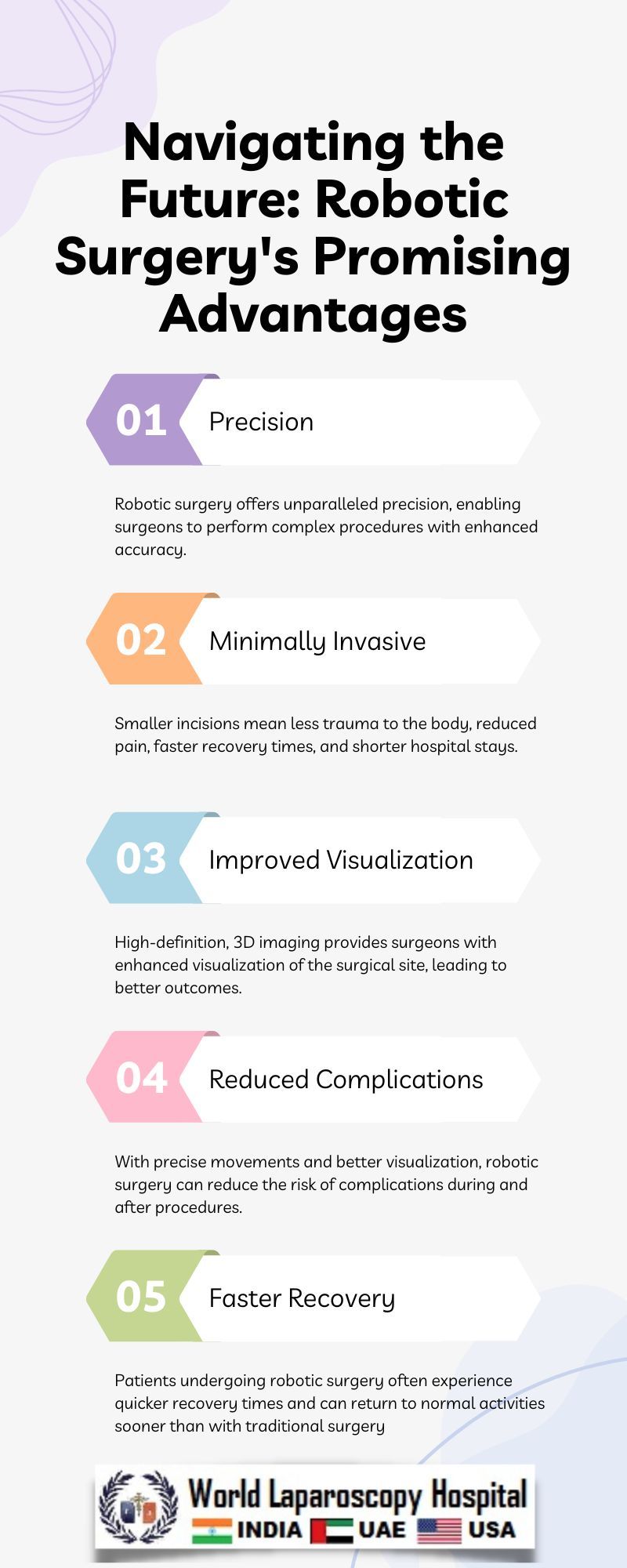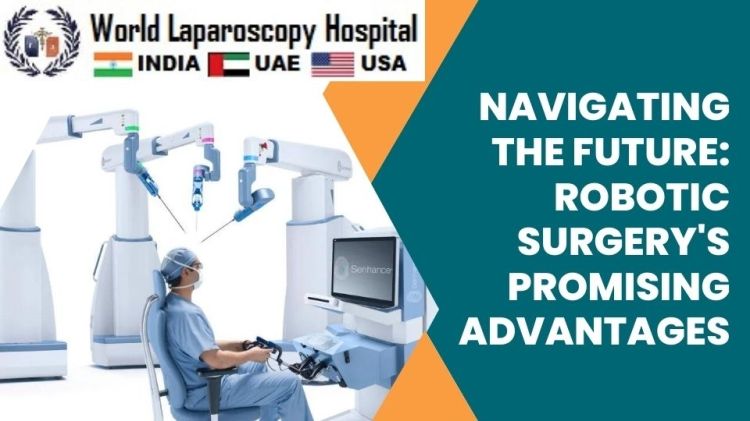Navigating the Future: Robotic Surgery's Promising Advantages
Introduction:
In the rapidly evolving landscape of healthcare, technological advancements continue to revolutionize medical practices. Among these innovations, robotic surgery stands out as a promising frontier, offering a multitude of advantages that are reshaping the way surgeries are performed and patient care is delivered. This article explores the intricacies of robotic surgery, delving into its transformative capabilities and the potential it holds for the future of medicine.

Understanding Robotic Surgery:
Robotic surgery, also known as robot-assisted surgery, involves the use of robotic systems to aid surgeons in performing complex procedures with precision and control. Unlike traditional surgery, where the surgeon operates directly on the patient, robotic surgery employs a minimally invasive approach. A surgeon controls the robotic arms from a console, guiding miniature instruments inserted into the patient's body through small incisions.
The Evolution of Robotic Surgery:
The concept of robotic surgery dates back to the 1980s, with the development of the first robotic surgical system, PUMA 560. However, it wasn't until the late 1990s that the da Vinci Surgical System, created by Intuitive Surgical, emerged as a breakthrough technology in the field. Since then, robotic surgery has experienced significant advancements, with improvements in robotic platforms, instrumentation, and surgical techniques.
Advantages of Robotic Surgery:
Robotic surgery offers a plethora of advantages over traditional surgical approaches, benefiting both surgeons and patients alike. One of the primary advantages is enhanced precision. The robotic arms can make precise movements with greater accuracy than the human hand, minimizing the risk of errors and complications during surgery.
Moreover, robotic surgery enables surgeons to perform complex procedures with improved visualization and magnification. High-definition 3D imaging provides a detailed view of the surgical site, allowing for better anatomical orientation and tissue differentiation. This enhanced visualization contributes to better surgical outcomes and reduced damage to surrounding healthy tissue.
Additionally, robotic surgery offers patients several benefits, including shorter hospital stays, faster recovery times, and reduced post-operative pain. The minimally invasive nature of robotic procedures results in smaller incisions, leading to less blood loss, lower risk of infection, and quicker healing compared to traditional open surgery. As a result, patients can return to their normal activities sooner, with less discomfort and a lower likelihood of complications.
Applications of Robotic Surgery:
Robotic surgery has found applications across various medical specialties, ranging from general surgery to highly specialized fields such as urology, gynecology, and cardiothoracic surgery. In urology, robotic-assisted prostatectomy has become the standard of care for the treatment of prostate cancer, offering improved oncologic outcomes and reduced morbidity compared to traditional approaches.
Similarly, in gynecology, robotic surgery is utilized for procedures such as hysterectomy and myomectomy, allowing for precise removal of diseased tissue while preserving surrounding organs and tissues. In cardiothoracic surgery, robotic-assisted procedures enable surgeons to perform intricate operations with greater precision, particularly in minimally invasive cardiac and thoracic surgeries.
Challenges and Limitations:
Despite its numerous advantages, robotic surgery is not without its challenges and limitations. One significant concern is the cost associated with robotic systems, which can be prohibitively expensive for many healthcare institutions. The initial investment in purchasing the robotic platform, along with ongoing maintenance and instrument costs, presents a financial barrier to widespread adoption.
Moreover, there is a learning curve associated with mastering robotic surgical techniques. Surgeons must undergo specialized training to become proficient in operating the robotic system effectively. This training requires time and resources, and not all surgeons may have access to adequate training opportunities.
Another limitation of robotic surgery is the lack of haptic feedback, which refers to the sense of touch and force feedback experienced during traditional surgery. While the robotic system provides visual and auditory feedback, the absence of tactile feedback can potentially compromise the surgeon's ability to assess tissue characteristics and manipulate delicate structures accurately.
Future Directions and Innovations:
Despite these challenges, the future of robotic surgery appears promising, with ongoing advancements and innovations aimed at overcoming current limitations. One area of development is the integration of artificial intelligence (AI) and machine learning algorithms into robotic systems. AI can analyze vast amounts of surgical data to provide real-time assistance to surgeons, improving decision-making and optimizing surgical outcomes.
Furthermore, researchers are exploring the potential of miniature robotic systems for use in microsurgery and minimally invasive procedures. These smaller robots could navigate through intricate anatomical structures with greater precision, opening up new possibilities for the treatment of conditions such as neurological disorders and vascular diseases.
Conclusion:
Robotic surgery represents a paradigm shift in surgical practice, offering unprecedented precision, control, and patient outcomes. While challenges remain, the continued evolution of robotic systems and techniques holds immense promise for the future of medicine. As technology continues to advance, robotic surgery will undoubtedly play an increasingly prominent role in navigating the complexities of modern healthcare, shaping a future where surgical interventions are safer, more effective, and more accessible than ever before.



